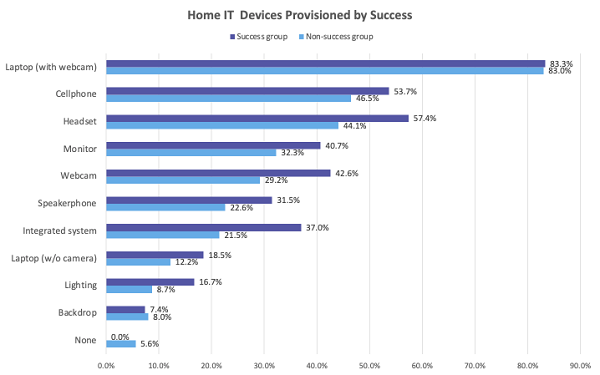In an effort to improve the voice and video experience for remote workers, a number of vendors including Cisco, Jabra, Logitech, Microsoft, Neat, and Poly have introduced new audio and video devices aimed at personal use, either in the office or at home. Form factors vary: stand-alone cameras and speakerphones; integrated audio and video bars; all-in-one solutions that combine a touch-enabled monitor, camera, microphone, and speakers into a single form factor. These devices differ from consumer-grade offerings in several ways, including the abilities to leverage AI to reduce or eliminate background noise, to compensate for low-light conditions, and to enable IT to centrally manage the devices to ensure firmware updates and to gather performance data.
Metrigy’s global Unified Communications Management and Endpoints: 2021-22 research study of approximately 400 end user organizations found significant buyer-side interest in these devices, specifically among those responsible for UC purchasing and/or operations within their organizations.
We noted in our study:
- Just 61% of participants say that built-in cameras in laptops and PCs are sufficient for their needs. The rest note that sufficiency depends on camera, or an employee’s specific needs
- 29% of all participants, and 43% of our success group (defined as those with the highest ROI and/or productivity gain for their UC investments) have deployed, or plan to deploy stand-alone high-quality webcams to improve video experiences. Of those provisioning high-quality webcams, more than half (53%) are providing them to remote employees
- 62% of all participants, and 72% of our success group, say they see value in equipping employees with high quality UC endpoints
Given the growing interest in these devices, the challenge for IT leaders is to determine how best to deploy them. This can be especially challenging for hybrid employees who split time between the office and home. About 52% of participants say they plan to provision separate devices for home and office, while 25% will require employees to bring their own devices with them. For those using hot-desking in the office, a common approach is to provision a high-quality camera to the desk, but ask employees to bring their headsets with them when they come into the office. Alternatively, companies may set up lockers to allow employees to store personal headsets in the office.
How to Provision Devices?
Another key challenge is determining a provisioning strategy. Just 55% of companies providing high-quality audio and video endpoints will provide them to all employees. Other popular use cases include executives, customer service representatives engaging with customers via video, and for salespeople . In each of these last two cases, the use of high-quality cameras and audio devices potentially allows the organization to differentiate itself via a higher quality voice and video customer-facing experience. They key to success here is for IT leaders to work with their business counterparts to develop a persona strategy to ensure that those who can most benefit from these devices are able to obtain them.
A final challenge is funding the purchase of high-quality voice and video devices. Here, companies utilize a variety of approaches including providing a stipend to employees to allow them to purchase the devices they want, to IT purchasing and provisioning the devices, to line of business funding purchase.
Provisioning these devices to remote employees generally correlates with success as shown in the below chart. Here the purple bars indicate the percent of companies in our success group provisioning each device, compared to the percent of those not in the success group (shown in the blue bars)
Managing Devices
Almost 46% of our participants are now implementing IT management of remote devices, initially mostly focused on headsets. We expect companies to leverage headset management apps like Jabra Direct, Logi Tune, Poly Lens, and Sennheiser Smart Control to manage a broader set of audio and video devices as they are deployed. Centralized management is a key differentiator compared to consumer-grade devices like Apple AirPods or similar devices from Samsung and others as it allows for IT groups to ensure consistent provisioning, updates, inventory control, performance management. In some cases, device management apps are capable of sharing data with UC management platforms as well.
Recommendations
The value of improving voice and video experiences via high-quality cameras and audio devices is often difficult to quantify. However, our research has shown companies with the highest ROI and/or productivity gains for their collaboration investments are more likely to leverage these devices for both in-office and remote employees. Consider evaluating the options that are out there today, with an eye toward leveraging devices that integrate with your current endpoint management strategy, and adopting a broad approach that provides high quality endpoints to anyone who spends a great deal of time in virtual meetings.











